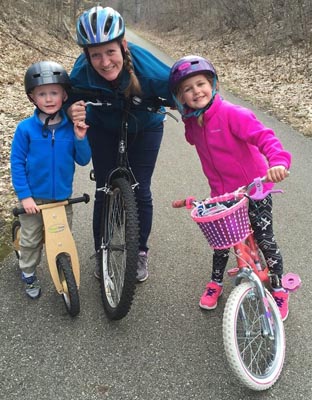October 17, 2017

It was finally time to teach my daughter Reese, then age 4, to ride a bike. She was old enough and had the honest desire to learn, so we started her off with a Craigslist bike that came with removable training wheels. After all, both my wife and I had learned using exactly the same approach – a hand-me-down bike with training wheels.
After months of practice, we removed the training wheels with the expectation of her first solo ride. She struggled, and after hours of running alongside her holding the bike, I put the training wheels back on.
At the same time, her younger brother had inherited a balance bike – a bike without pedals where kids push themselves with their feet. In only a few months, and at a much younger age than his sister, my son was riding confidently. We switched my daughter to a balance bike, and very soon after she was enjoying the freedom of riding without dad attached to her seat.
Balance bikes are just starting to catch on in the United States, but have become the norm in places like Australia and the United Kingdom. Research has shown that kids learn faster
using balance bikes than training wheels.
So, where are we still using the familiar training wheels in education, when a better balance bike approach is available?
Standards
Training wheels – discrete list of topics and concepts that students need to learn as the sole learning goals. Example:
Common Core math standards.
Balance bike – showing connections between different topics, with thinking and reasoning as an additional goal. Example:
Common Core mathematical practices.
Instruction
Training wheels – passive lecture-based instruction followed by independent student practice.
Balance bike – collaborative group work, where students actively construct knowledge together through discussion.
Assessment
Training wheels – using only assessments with multiple choice, rote-memorization and fact recall, which measure narrowly defined outcomes.
Balance bike – multiple types of assessment, including free response, group discussion, student projects, speeches and presentations where students can demonstrate their understanding much more broadly.
Accountability
Training wheels – Teachers are ultimately responsible for student learning.
Balance bike – Administrators, teachers, and families share responsibility for student learning. Students are empowered to take ownership of their own education.
There’s a good chance you learned to ride a bike using training wheels, and there’s also a good chance you learned from teachers using “training wheels” approaches to education. While we were eventually successful with these dated systems, we must ask ourselves now if this is still the best way for us to educate students.
What other educational systems are in place simply because they are familiar? Challenging our assumptions in education means reflecting on our own practices, no matter how attached to them we are.
 Luke Wilcox is Michigan’s Teacher of the Year for 2017-18, and Meemic is proud to partner with the Michigan Department of Education for the program. He’s the mathematics department chairperson at East Kentwood High School in Kentwood Public Schools, where he’s spent his entire 16-year career.
Luke Wilcox is Michigan’s Teacher of the Year for 2017-18, and Meemic is proud to partner with the Michigan Department of Education for the program. He’s the mathematics department chairperson at East Kentwood High School in Kentwood Public Schools, where he’s spent his entire 16-year career.